The world of football is typically thought of as being a macho and male-dominated one. In recent years, women’s football has begun to get back to the heights that it was at before the Football Association inexplicably chose to ban it in 1921. Even so, football stadiums tended to reflect the overly-masculine environment that the sport had become, with steel dominating their look and sharp angles being the overriding feature.
As modern football has developed, however, some stadiums have become note-worthy for their architectural impressiveness. Older ones that have always been there suddenly started to get noticed for offering more than just the paint-by-numbers experience that we’d come to expect. The homes of football teams that are interesting because of how different they are are worth noting, so that’s what we decided to do.
Čierny Balog – Slovakia
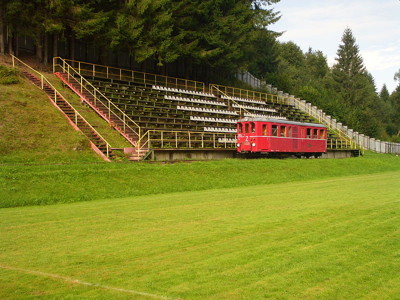
In some ways, there is nothing all that extraordinary about Čierny Balog, which can be found in the Brezno District of Slovakia. It is the home of TJ Tatran Čierny Balog Football Club, which is an amateur side in the country. It’s not exactly one of the most popular sides, so the stadium is relatively small and there is only one seated section to speak of. What makes it unusual is the fact that a train track runs alongside the pitch.
The track is located between the stand and the side of the pitch, meaning that spectators can have their view blocked by a train passing by if the match kicks-off at an inconvenient time. It is the only stadium in the world that has a train track running through it, with the railway line having been built in the 1900s in order to allow for the transportation of timber from Cierny Balog to Hronec.
In the years that followed, the line itself was developed to stretch to more than 120,000 miles; to say nothing of the fact that a football pitch was built next to it that had never existed before. Indeed, the football club was only formed in 1982, after the village had developed enough to warrant it. The railway line had stopped working at the point, but a decade on it was re-initiated to make one of the most interesting stadiums in the world.
The Float At Marina Bay – Singapore
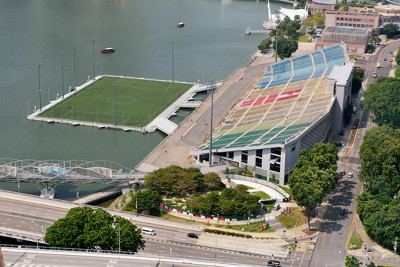 If you want your football stadium to be unusual then you’re going to struggle to get much better than the Float at Marina Bay, which can be found in the centre of Singapore. The name isn’t an exaggeration, either; it literally is a floating platform. Built in 2007 as a multi-purpose venue, it has hosted concerts, competitions and exhibitions. Impressive in and of itself, it also has room for nearly 30,000 supporters.
If you want your football stadium to be unusual then you’re going to struggle to get much better than the Float at Marina Bay, which can be found in the centre of Singapore. The name isn’t an exaggeration, either; it literally is a floating platform. Built in 2007 as a multi-purpose venue, it has hosted concerts, competitions and exhibitions. Impressive in and of itself, it also has room for nearly 30,000 supporters.
Entirely unsurprisingly, it is the largest floating football stadium in the world. Having decried the use of steel in the intro, you’ll forgive us waxing lyrical about its use in this instance, given that it helps to form a platform that measures 120 metres by 83 metres. It was first conceived of by the people responsible for organising 2007’s National Day Parade, with the National Stadium of Singapore out of use as it was due to be demolished.
That now houses the Singapore Sports Hub, which is where any football matches of note are played. Regardless, they can’t reach the sheer spectacle of a match played on a floating platform in the middle of a bay, with some of Singapore’s most impressive buildings as its backdrop. It boasts plenty of impressive things, such as drainage and lightning rods, but ultimately it’s a floating platform you can play a match on.
Borisov Arena – Belarus
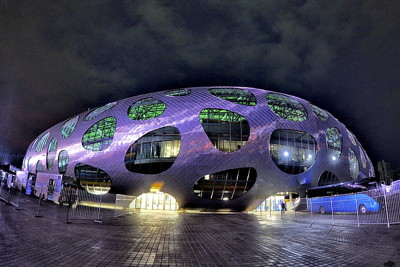
It is entirely fair to point out that Borisov Arena isn’t the biggest football stadium in the world, boasting seats for a little over 13,000 people. As many a man named Adam has pointed out in the past, however, it’s not the size of something but what you can do with it that counts. In the case of Borisov Arena, OFIS Architects created something that is genuinely startling to look at from the outside.
Inside the ground there’s not all that much to look at, but as you approach it from a distance it suddenly takes on a life of its own. The architects spoke of how their design took natural advantage of the stadium’s location as well as the terrain that it sits in, to say nothing of the forest that surrounds it. Yet it is the ‘skeleton’ of the ground that makes it truly impressive to look at, stretching over the rounded dome.
It appears as if there is a skin that has been stretched and perforated, which covers the arena and makes it look like one unified dome. The entire thing promotes excellent acoustics inside the ground, providing a fervent atmosphere on a match day. It took three years to build, officially opened in 2014 and cost about €40,000,000, but it is the striking nature of its looks that see it added to this list.
Century Lotus Stadium – China
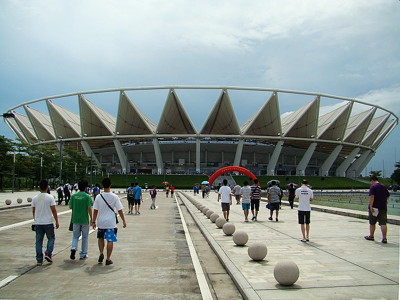
The Chinese have a long and illustrious history of creating beautiful buildings, so it’s really no surprise that they’ve carried that over in the modern era. Foshan in the Guangdong Province was gearing up to host the 12th Sports Meeting in 2006 and wanted to make sure that it could present itself a modern, growing city. As a result, a decision was taken to build a multi-purpose stadium that could serve the demands of the programme.
What they created was a circular stadium that offers a huge, white membrane as a roof. Its location on a hill means that it is reminiscent of a lotus blossom, thanks in no small part to the spoke-wheel-like roof that covers both the stands and the external concourse. It became something of a symbol for the games in 2006, with a swimming pool attached to the stadium and boasting a similar roof that seems to be unsupported over the water.
The Century Lotus Stadium has been shown appreciation from outside of China as well as inside. In 2008 it won an International Architecture Award of the Chicago Athenaeum, whilst a year later it was awarded a Silver Medal at the IOC / IAKS Award For Sports Facilities. With room for 36,686, it isn’t the biggest football stadium in China but there is certainly an argument that it is one of the most spectacular.
Fisht Olympic Stadium – Russia

When it was confirmed that Russia would be the host for the 2018 World Cup, there was some concern from the wider footballing community because there weren’t enough stadiums to host the amount of matches that would be played. There were more than a few grounds already being used for the sport, however, and the Fisht Olympic Stadium was one of them, having previously hosted the 2014 Winter Olympics and Paralympics.
Designed by Global Design Practice Populous and the British design consultancy BuroHappold Engineering, the stadium’s roof is what makes it truly special. Created from ethylene tetrafluoroethylene, it was made with the idea being that it would give the roof an appearance of having snowy peaks. From the outside, it looks like a ski jump, with a long curvature that was originally closed off.
In January of 2015, a project began that would renovate the stadium in order to use it as one of the host venues for the 2017 Confederations Cup and the World Cup a year later. One of the big chances was to open the roof, which would ensure that the ground complied with FIFA regulations. This merely served to add to the spectacle, with the new-look stadium being one of the most impressive sights in Russian football.
Allianz Arena – Germany
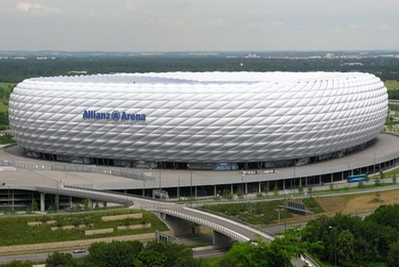
There are few sights in world football as well-known and as architecturally interesting as Bayern Munich’s home stadium, the Allianz Arena. Boasting a capacity of more than 75,000 for domestic matches, it is the inflated ETFE plastic panels on the outside of the ground that make it such a sight to see. There are 2,874 panels that are kept inflated by dry air, with little dots all over them.
When the stadium is viewed from a distance, the human brain combines the dots and makes it appear as if it is one large mass. When viewed up close, however, you can actually see through the dots. The most impressive thing about it is that each of the dots can be lit up either white, red or blue and they operate independently of one another. This allows the stadium to be lit up in different colours.
Munich Police encourage the Allianz Arena to use either a single-colour scheme owing to the fact that there have been car accidents on the A9 Autobahn when interchanging lighting schemes have been used in the past. It says something for the brilliance of the stadium’s design that it was later copied by other grounds, such as the MetLife Stadium in New Jersey, United States of America.
Beijing National Stadium – China
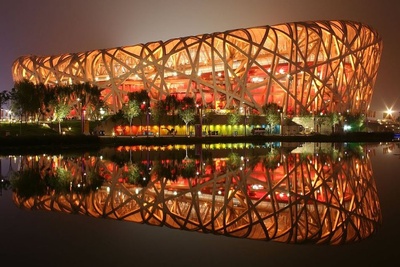
It is back to China for one of the most beautiful stadiums on our list, though it is worth noting that it only really comes to life at night. Built in time for the 2008 Summer Olympics, the venue is often referred to as the ‘Bird’s Nest’, for that is what it looks like. The stadium was designed by architects Jacques Herzog and Pierre de Meuron from Basel-based architecture team Herzog & de Meuron, as well as the project architect Stefan Marbach, artist Ai Weiwei, and CADG, led by chief architect Li Xinggang.
Reportedly inspired by traditional Chinese ceramics, it appears to be a swirling mass of steel that goes up and down the outside of the ground. As well as being used as a host venue for the 2008 Summer Olympics and Paralympics, in addition to the 2022 Winter Olympics and Paralympics, it is also regularly used as the host ground for the Chinese national football team. It was built so that the Northern and southern stands are lower than the eastern and western ones, to improve sight lines.
As you might imagine for such a modern and impressive venue, there are all sorts of technological and design things that make it stand out from the crowd. For starters, there is a rainwater collector close to the stadium that collates and purifies rain water before using it to serve the ground itself. There are also pipes underneath the stadium that heat it up in the winter and cool it down in the summer.
Ōita Bank Dome – Japan
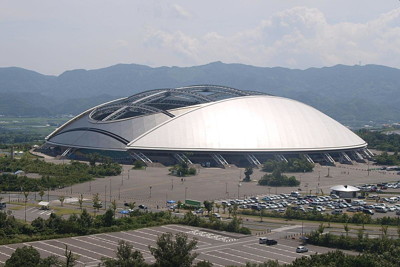
Located in Ōita on the Japanese island of Kyushu, the Ōita Bank Dome is nicknamed ‘the Big Eye’. This is because it bears a shape not dissimilar to an eye and has a retractable roof that makes it look as if it is blinking really slowly when it opens and closes. It opened in May 2001 and was used as a venue for the 2002 FIFA World Cup. In the wake of the tournament, 3,000 seats were removed, reducing its capacity to 40,000.
The home ground of the J League team Ōita Trinita, it was designed by architect Kisho Kurokawa and is used at any point that Japan plays host to a major sporting event. In spite of its incredibly interesting look, it only hosted three matches during the 2002 World Cup and was actually used more when it was one of the venues that hosted Rugby World Cup matches 17 years later.
Even non-sports fans will often take a trip to the Ōita Bank Dome when in Japan, largely because of its architectural pedigree. It is one of the best-known examples of the Metabolist Movement in Japanese architecture, which was founded by Kurokawa and his contemporaries. If you’re considering football stadiums that are unusual or artistic, it is impossible to ignore one that is a shining example of an entire movement of Japanese architecture.
